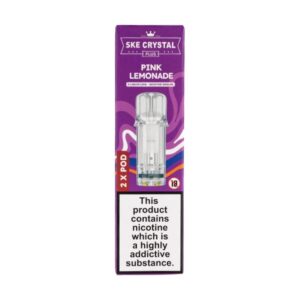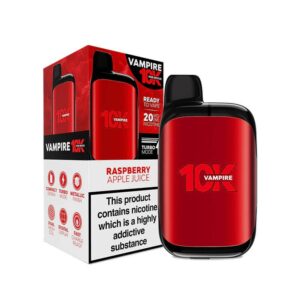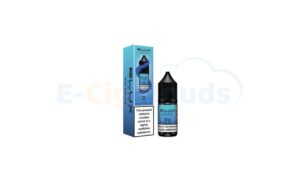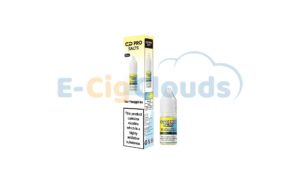
Guide to E-Liquids
Understanding E-Liquids
E-liquids are the essential fuel for electronic cigarettes and vaping devices. These specialised liquids, also known as vape juice or e-juice, transform into an inhalable vapour when heated by your device’s atomiser.
Key Components of E-Liquids:
1. Propylene Glycol (PG)
- Carries flavours effectively
- Creates the signature throat hit
- Thinner consistency for easy absorption
- Common in food and pharmaceutical products
2. Vegetable Glycerin (VG)
- Produces thick, satisfying vapour clouds
- Delivers a smoother inhale
- Slightly sweet taste
- Higher density than PG
The ratio between PG and VG in your e-liquid directly impacts your vaping experience. A higher PG content (like 70/30 PG/VG) delivers stronger flavours and a more pronounced throat hit, making it ideal for ex-smokers seeking a familiar sensation. VG-dominant blends create denser clouds and suit direct-lung vaping styles.
Understanding E-Liquid Labels
Your e-liquid bottle displays crucial information:
- PG/VG ratio
- Nicotine strength
- Flavour profile
- Batch number
- Expiry date
Premium brands like SKE and Lucky 7 maintain strict quality standards in their e-liquid production. Each ingredient undergoes thorough testing to ensure safety and consistency.
Why Understanding E-Liquid Components is Important
Knowing the different parts that make up e-liquids can help you in several ways:
- Choose the best product for your vaping device
- Get the specific vaping experience you want
- Prevent any allergic reactions you might have
- Make smarter choices when buying e-liquids
- Fix common problems that may arise
The quality of your e-liquid directly affects how much you enjoy vaping. When you use top-notch ingredients, you’ll get a more intense flavour, consistent vapour production, and a smoother overall experience. This understanding is crucial for making your switch to vaping enjoyable and successful.
Nicotine Strengths and Types in E-Liquids
E-liquids come in various nicotine concentrations, ranging from 0mg to 20mg in the UK market. This variety allows users to select strengths that match their smoking habits:
- 0mg: Ideal for non-nicotine vapers
- 3mg-6mg: Suited for light smokers
- 12mg: Perfect for moderate smokers
- 18mg-20mg: Designed for heavy smokers
Types of Nicotine in E-Liquids
Two primary types of nicotine exist in e-liquids:
Freebase Nicotine
- Traditional form used in cigarettes
- Delivers a stronger throat hit
- Works best in lower concentrations
- Ideal for sub-ohm vaping devices
Nicotine Salts
- Smoother throat sensation
- Faster nicotine absorption
- Higher concentrations without harshness
- Popular in pod systems and starter kits
Premium brands like Aroma Kings offer both nicotine types across their range, ensuring vapers can find their preferred strength and sensation. The ability to gradually reduce nicotine levels makes e-liquids an effective tool for managing nicotine intake, allowing users to step down concentrations at their own pace.
Users new to vaping often start with nicotine salts in higher strengths, then transition to freebase nicotine as they adjust their vaping style and preferences. This flexibility in nicotine options helps create a personalised vaping experience that satisfies individual needs.
Popular E-Liquid Brands and Their Offerings
The UK vaping market is home to several renowned e-liquid manufacturers, each offering distinct flavour profiles and quality standards to vapers.
1. AU Gold
AU Gold stands out with their premium vape liquid collection:
- Signature fruit medleys
- Rich dessert blends
- Precise nicotine measurements
- High-grade ingredients
Try RED A AU GOLD 100ML E LIQUID by KINGSTON
2. Elux Liquid
Elux Liquid has built a reputation for innovation in the vaping industry. Their Elux vape juice range includes:
- Classic Collection: Traditional tobacco flavours
- Fruit Fusion Series: Exotic fruit combinations
- Dessert Line: Sweet treat inspirations
- Custom nicotine strength options
Try MR BLUE 10ML NIC SALT by ELUX LEGEND
3. Oxva
Oxva brings scientific precision to e-liquid manufacturing:
- Advanced flavour extraction methods
- Balanced PG/VG ratios
- Laboratory-tested formulations
- Specialised coil-friendly mixtures
Try CHERRY FIZZ 10ML NIC SALT OX PASSION by OXVA
Each brand maintains strict quality control measures, ensuring their e-liquids meet UK safety standards. These manufacturers use pharmaceutical-grade ingredients, creating products suitable for different vaping styles and preferences.
The growing popularity of these brands stems from their commitment to:
- Consistent flavour profiles
- Quality manufacturing processes
- Diverse product ranges
- Regular safety testing
- Customer satisfaction focus
These established brands continue to shape the vaping industry through research, development, and consumer feedback integration.
Choosing the Right E-Liquid for Your Device
Selecting compatible vape juice for your device plays a crucial role in achieving the perfect vaping experience. Different devices require specific e-liquid formulations to perform at their best.
For Starter Kits and Pod Systems:
- 50/50 VG/PG ratio works best
- Higher nicotine strengths (12-20mg)
- Nicotine salts are ideal
- Thinner consistency for optimal wicking
For Sub-ohm Devices and Advanced Mods:
- High VG content (70% or higher)
- Lower nicotine levels (0-6mg)
- Thicker consistency
- Designed for direct-lung inhale
The power output of your device directly impacts e-liquid selection:
- Low-wattage devices (10-20W): Use higher PG ratios
- High-wattage devices (50W+): Choose high VG blends
Device-Specific Considerations:
- Check coil resistance compatibility
- Review manufacturer recommendations
- Consider tank capacity
- Examine airflow settings
Matching your e-liquid to your device prevents issues like:
- Burnt coils
- Poor vapour production
- Leaking tanks
- Unsatisfying nicotine delivery
The right combination enhances flavour delivery, creates satisfying clouds, and extends the life of your vaping components.
Proper Storage and Maintenance of E-Liquids
Proper storage of vape juice plays a crucial role in maintaining its quality and extending its shelf life. The three main factors that affect e-liquid quality are:
- Temperature – Store between 15-20°C in a cool, dry place
- Light exposure – Keep away from direct sunlight
- Air contact – Ensure bottles remain tightly sealed
A kitchen cupboard or drawer provides ideal storage conditions for your e-liquids. Avoid bathroom cabinets where temperature fluctuations and humidity levels can degrade the liquid’s quality.
Signs of Improper Storage
Look out for the following signs that indicate your e-liquid may have been improperly stored:
- Darkening colour
- Separation of ingredients
- Altered taste
- Reduced vapour production
- Weakened nicotine strength
When e-liquid oxidises through air exposure, the nicotine reacts with oxygen, causing the liquid to darken and develop a peppery taste. This chemical reaction also reduces the nicotine potency.
Best Practices for E-Liquid Storage
To ensure the longevity and quality of your e-liquids, follow these best practices:
- Store bottles upright to prevent leakage
- Keep out of reach of children and pets
- Check expiry dates regularly
- Use within 1-2 years of purchase
- Avoid extreme temperatures
Glass bottles offer better protection against oxidation compared to plastic containers. If you notice any unusual changes in your e-liquid’s appearance or taste, it’s best to replace it with fresh stock.
Health Considerations When Using E-Liquids
Understanding how e-liquids work can help us see why they’re different from regular smoking. When you heat up e-liquid in a vape, it turns into a mist made mostly of water vapour and carbon dioxide. This is very different from what happens when you burn tobacco, which creates tar and many harmful substances.
Key Health Benefits of Vaping E-Liquids:
- No burning means no tar or carbon monoxide exposure
- Controlling the temperature prevents harmful substances from forming
- The ingredients in e-liquids break down into simpler and less harmful compounds
Research suggests vaping could serve as a harm reduction tool for smokers seeking alternatives. The Royal College of Physicians has stated that vaping carries a fraction of the health risks associated with traditional smoking.
Essential Safety Practices:
- Only buy e-liquids from trusted manufacturers
- Check the ingredient list for any allergens
- Keep an eye on how much nicotine you’re consuming and adjust the strength if necessary
- Drink plenty of water while vaping to counteract the slight dehydrating effects of PG
The NHS acknowledges vaping as a way to quit smoking, but it’s important to remember that e-cigarettes work best when combined with other methods to stop smoking. Users should have regular check-ups with their doctors and let them know about any negative reactions.
Can I Make My Own Vape Juice?
Creating your own vape juice offers a personalised vaping experience and potential cost savings. The process requires careful attention to detail and proper safety measures.
Essential Ingredients
- Vegetable Glycerin (VG): The base liquid that produces thick vapour
- Propylene Glycol (PG): Carries flavour and creates throat hit
- Nicotine: Available in various strengths (optional)
- Flavour concentrates: Wide range of options for customisation
- Sterile bottles: For mixing and storage
- Safety equipment: Gloves, goggles, and precise measuring tools
Step-by-Step Mixing Guide
1. Calculate Your Measurements
- Determine desired VG/PG ratio
- Choose nicotine strength
- Plan flavour percentages (typically 10-20%)
2. Preparation
- Clean workspace thoroughly
- Put on safety equipment
- Gather all ingredients and tools
- Label empty bottles
3. Mixing Process
- Add VG base
- Pour PG base
- Add nicotine carefully
- Include flavour concentrates
- Shake thoroughly for 2-3 minutes
Safety Precautions
- Store ingredients in a cool, dark place
- Keep away from children and pets
- Use nitrile gloves when handling nicotine
- Label all bottles with contents and date
- Mix in a well-ventilated area
Customisation Tips
Flavour Combinations
- Start with single flavours
- Record successful recipes
- Test different percentages
- Allow steeping time for optimal taste
Nicotine Adjustments
- Begin with lower strengths
- Test small batches first
- Increase gradually if needed
- Use nicotine calculators for accuracy
VG/PG Balance
- Higher VG for cloud production
- More PG for stronger throat hit
- Common ratios: 70/30, 60/40, 50/50
- Consider device compatibility
Making your own vape juice requires patience and precision. Start with basic recipes and gradually experiment with more complex combinations as you gain experience. Keep detailed notes of your successful mixes and always prioritise safety in your DIY vaping journey.
Understanding Bottle Sizes
E-liquid bottles come in various sizes to accommodate different vaping habits and preferences. The standard range includes:
- 10ml bottles: Perfect for sampling new flavours
- 30ml bottles: Ideal for casual vapers
- 50ml bottles: Popular mid-range option
- 100-120ml bottles: Best value for heavy vapers
Smaller 10ml bottles serve as an excellent starting point for exploring new flavours without committing to a large quantity. These compact sizes reduce the risk of wastage if you discover a flavour isn’t to your taste.
For regular vapers, larger bottles (50ml-120ml) offer significant cost savings. These sizes typically provide better value per millilitre and require less frequent reordering. Many experienced vapers opt for these larger quantities for their favourite flavours.
Smart Inventory Management Tips:
- Keep track of your usage patterns to determine optimal bottle sizes
- Consider purchasing smaller bottles for experimental flavours
- Buy larger quantities of tried-and-tested favourites
- Check expiry dates when buying in bulk
- Store unopened bottles properly to maintain freshness
Understanding your vaping habits helps determine the most practical bottle size for your needs. Regular vapers might benefit from mixing bottle sizes – larger ones for daily favourites and smaller options for variety and experimentation.
Insights from UK Vape Shops – Brands & Product Range
The UK vape market offers an extensive selection of high-quality brands and products through trusted retailers. E-Cig Clouds stands as a prime example, stocking premium brands that cater to diverse vaping preferences.
Popular UK Vape Brands:
- Elf Bar – Known for innovative disposable devices and e-liquids
- Lost Mary – Specialises in flavour-rich nicotine salt formulations
- Crystal – Offers premium quality e-liquids with unique taste profiles
- Hayati – Creates authentic Middle Eastern-inspired flavours
- Kingston – Produces affordable yet high-quality e-liquid ranges
UK vape shops maintain strict quality standards, ensuring all products meet TPD regulations. Many retailers offer specialised services:
- In-store flavour testing stations
- Expert staff consultation
- Device compatibility guidance
- Regular product updates
- Loyalty programmes
The product range spans from basic starter kits to advanced vaping systems. E-liquid selections include:
- Traditional tobacco blends
- Fruit medleys
- Dessert-inspired flavours
- Menthol variations
- Beverage-based options
UK vape shops prioritise customer education, offering guidance on selecting appropriate products based on individual vaping goals and experience levels. This customer-centric approach helps create a supportive environment for both new and experienced vapers.
FAQs
What are the main components of e-liquids and how do they affect vaping experience?
E-liquids primarily consist of Propylene Glycol (PG) and Vegetable Glycerin (VG). PG carries flavours and creates a stronger throat hit with a thinner consistency, while VG produces thick vapour clouds with a smoother inhale and a slightly sweet taste. The PG/VG ratio significantly influences the vaping experience, affecting flavour intensity, vapour production, and throat sensation.
How do nicotine strengths and types vary in e-liquids?
Nicotine strengths in e-liquids range from 0mg (non-nicotine) to 18-20mg for heavy smokers, with intermediate levels like 3-6mg for light smokers and 12mg for moderate smokers. There are two main nicotine types: Freebase Nicotine, which provides a stronger throat hit, and Nicotine Salts, which offer a smoother throat sensation. Brands like Aroma Kings provide both types to suit different preferences.
What factors should I consider when matching e-liquid to my vaping device?
Device-specific considerations include coil resistance compatibility, manufacturer recommendations, tank capacity, and airflow settings. Properly matching your e-liquid to your device helps prevent issues such as burnt coils, poor vapour production, leaking tanks, and unsatisfactory nicotine delivery. The right combination enhances flavour delivery, produces satisfying clouds, and extends the life of vaping components.
How should I properly store e-liquids to maintain quality?
E-liquids should be stored upright in a cool, dry place at temperatures between 15-20°C. Avoid exposure to light and air contact to prevent oxidation. Glass bottles are preferable as they better protect against oxidation compared to plastic containers. Regularly check expiry dates and use e-liquids within 1-2 years of purchase. Improper storage can lead to darkening colour, ingredient separation, altered taste, reduced vapour production, and weakened nicotine strength.
What safety practices should I follow when purchasing and using e-liquids?
Always buy e-liquids from trusted manufacturers or retailers to ensure quality and safety. Check ingredient lists carefully for potential allergens. Monitor your nicotine consumption and adjust strength as necessary to suit your needs. Avoid DIY mixing without proper knowledge or equipment unless you follow strict safety protocols including sterile bottles and accurate measurements.
What options are available in the UK vape market for e-liquids and devices?
The UK vape market offers high-quality brands such as Elf Bar (disposable devices), Lost Mary (nicotine salt formulations), Crystal (premium e-liquids), Hayati (Middle Eastern-inspired flavours), and Kingston (affordable ranges). Trusted retailers like E-Cig Clouds provide expert staff consultation, in-store flavour testing, device compatibility guidance, loyalty programmes, and a wide product range from starter kits to advanced systems with various e-liquid flavours.




